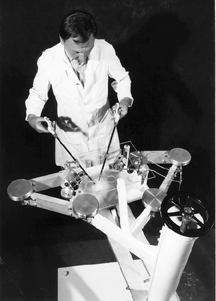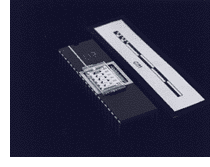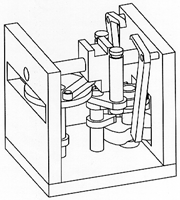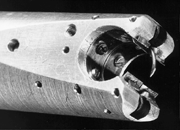

In this issue...
Laparoscopic Stand
|
The Newsletter of the |
Laparoscopy refers to visual inspection and surgery within the abdominal cavity with endoscopic tools. It means shorter recovery time, less infection risk, less pain and trauma for the patient, and reduced hospital costs. This rapidly growing field relies on video feedback and relatively primitive surgical instruments inserted through small incisions. The AMD-3 group is developing advanced endoscopic surgical devices to give doctors more dextrous control as well as tactile feedback and even automated suturing. Robotics, sensing, mechanism and actuator technologies combine to create new instruments beneficial for a wide range of minimally invasive surgeries.
Laparoscopic StandLaparoscopic positioning stand takes weight off surgeon's hands, reduces operating room crowding, gives more precise control, and allows position locking.Often when performing laparoscopic surgery doctors must maintain very demanding postures while holding various tools and graspers. The IS-9 group has developed a prototype passive assistive mechanism (SFU Laparoscopic Stand) that offers the surgeon a fixed structure for manipulating and holding tools in any desired configuration. This prototype is ready for clinical evaluation. The SFU Laparoscopic Stand will also be the basis for a master/slave tele-manipulation remote surgery system. During laparoscopic surgery it can be difficult for surgeons to know the exact 3D orientation of their tools inside a patient. The IS-9 group is developing a guidance system for surgeons that combines precise tool-position information from sensors on the SFU Stand with endoscopic video images and sonar depth soundings. The result is a 3D graphic surgical interface (GSI) that provides depth perception to guide surgical actions during both training and actual operations. Practicing surgeons are involved in the design process. The GSI system will be particularly useful for the demanding tasks of suturing and knotting. |

|
|
Dextrous ArmVarious design concept prototypes are in development. The new tools exploit the natural kinematic constraints of existing laparoscopic tools about the incision point. Such designs help surgeons regain dexterity that is missing in current laparoscopic tools. One typical design is thumb actuated. These ideas will ultimately go into the design of a master/slave tele-manipulator as part of the slave's coarse manipulation system. |

|
|
Force SensorEndoscopic surgery tools give very little tactile feedback to surgeons while they work on different tissues. Hence surgeons sometimes have trouble determining what they are grasping. The IS-9 group has developed a prototype of a micromachined pressure sensor assembly that could be incorporated into the gripping ends of an endoscopic surgery tool. The preliminary prototype pictured here is mounted on a standard chip package for testing. New tactile endoscopic tools will give surgeons varying pressure signals via the tool's handle grips depending on what the tool is grasping--fat, muscle, tumor, etc. |

|
|
Knotting MechanismThrough a comprehensive study of potential suture thread movements, IS-9 researchers have identified innovative relative motions that create loops required for suture slip knots. A prototype of a mechanism based on these movements is in development. In addition, several other assistive mechanisms for different types of knots are in various stages of research and development. |

|
|
Suturing HeadThis prototype mechanism can help a surgeon perform various suturing tasks. A unique feature of the design is the way it performs natural needle movement during suturing. In addition, the same design can be made to tie knots. A thumb actuated mechanism moves the needle. Several up-grades will miniaturize the design and ready it for clinical evaluation. |

|
Ash Parameswaran,
Micromachining Lab, SFU, (PI)
291-4971
param@cs.sfu.ca
Alex Nagy, MD, Dept.
of Surgery, UBC, (PI)
873-1885
Ron Podhoredeski,
Mechanical Engineering, U. Victoria, (PI)
721-8696
podhoro@sirius.uvic.ca
Lawrence Turner, MD, Fraser Burrard Hospital Society
Hendrik Van Derwal and Willie Rascan, SFU Machine Shop